How the Homeless Camps on 39th Street Under the Freeway Were Cleaned Up

39th Street before the cleanup. There are four sets of camps, two large ones on the south (right) side, and two smaller ones on the north.
Leslie Evans
The long block of 39th Street between Flower Street and Grand Avenue here in Los Angeles, that runs under the Harbor Freeway, has long been a tent small town for the homeless. Maybe 30 people live there. Usually it is an unbroken façade of camping tents. But on Tuesday, August 16, the city was due to arrive for a cleanup. It had been posted for a day or two in flyers taped to the underpass walls, to start at 8:00 am.
I got there around 7:40. A few of the tents were already gone and people were carrying or wheeling bulky belongings out from under the freeway and stacking them up on Flower to the west or Grand to the east. An extraordinary collection of furnishings was materializing.

Getting ready to move around the corner.
I guess I had come to think of homeless property as pretty much limited to a tent, mattress, sometimes a discarded chair or sofa, clothing and bedding. One elderly black man had a large hand-truck and was making trip after trip from 39th Street to a growing stack of belongings around the corner on Flower. He ferried over two sofas, several chairs, a two-drawer file cabinet, a wall medicine chest with a mirror, several bicycles and a large assortment of blankets. His new area was marked off with a string, tied to an electric treadmill standing on end.
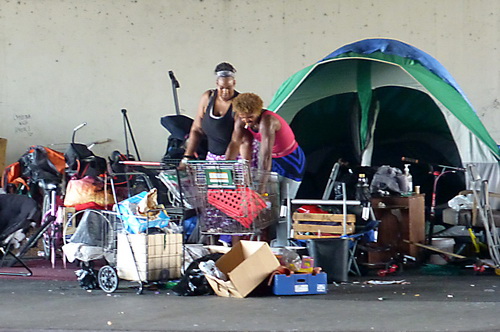
Under the freeway there were suitcases, a new generator, many ice chests and of course, shopping carts.
Across the street there were tables, a dresser without drawers, a 4-foot-high empty wooden picture frame, milk crates and large plastic tubs, more bicycles and bedding.
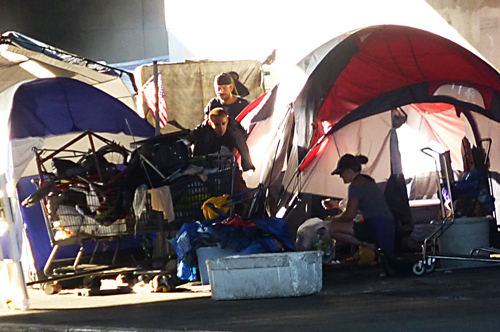
More negatively, there were lots of bags and boxes of spoiled food, trash, and bottles of urine – a Sanitation worker told me later that the bottles were to keep the street from smelling bad.
Around 8:15 a city pickup truck arrived, towing a porta potty, the first sign that the cleanup was really going to take place. The potty was for the city workers, not for the denizens of the tents. Soon there were several small trucks, a police car from Newton Division east of the freeway, and a few official-looking vans with city insignia on their sides. Sanitation workers showed up in their bright orange and yellow vests, three Hazmat specialists in head-to-toe white suits with masks, carrying large sprayer cans of disinfectant, and even two Watershed Protection officers to see that no nasty liquids were dumped in the storm drains.
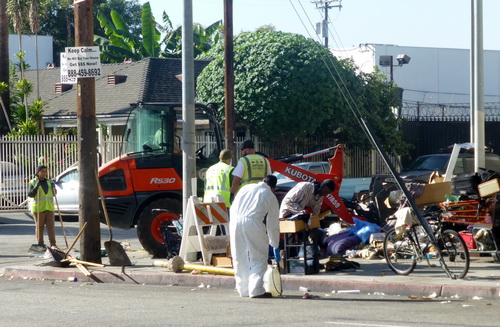
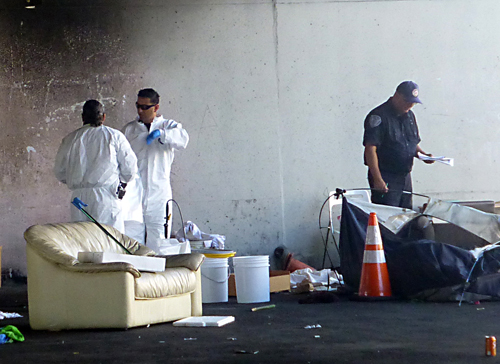
I asked one of the Sanitation workers why the people bothered to move their tents and belongings just a few yards away around the corners. Wouldn’t they be picked up from there just as much as under the freeway? “We posted only for 39th Street,” he said. “We legally have to leave them an exit, so even if their stuff is a few inches off of 39th Street on Flower or Grand we won’t touch it. As soon as the cleanup is over, they’ll move it right back.”

Homeless belongings on Flower Street that had been carried away from the cleanup.
How often do they do this? One of the Newton officers told me there had been a cleanup just two months ago. I photo the street once a month and never saw the camps reduced enough to guess anything had happened. “Many of the homeless actually appreciate the cleanup,” the cop told me. “It gets rid of all the garbage.”

There were two dogs living in the tent colony.
Homeless Services Were Out in Force
There were teams on hand from several homeless service agencies offering transportation to shelters to the people being moved. The County Department of Mental Health was going tent-to-tent. And teams were working the crowd from the Los Angeles Homeless Services Authority and HOPICS (Homeless Outreach Program Integrated Care System). Outreach workers from both of these organizations told me they had come out for the four previous days, but with little to no success. At most, two or three today seemed ready to agree to go to a shelter. Another organization, Fathers and Mothers Who Care, had also been canvassing this group of homeless for several weeks anticipating the cleanup.
The two largest nearby shelters, run by Volunteers of America, in preparation for this fairly large group, was holding reserve beds for the 16th. They operate Pathways To Home, 3804 S. Broadway Place, LA 90037, for adult men, and the Center for Life, 8770 S. Broadway, LA 90037, for adult women. To be more accommodating they had just changed from nights-only to allow 24-hour fairly indefinite stays.
Another local shelter is the Testimonial Community Love Center, 5721 S. Western Avenue, LA 90062.
One homeless man approached me as I was taking pictures and asked that I not use any photos that included his girlfriend, as she is pregnant. I assured him I wouldn’t and deleted that shot from my camera. I ask one man whose beard was just starting to turn gray how he happened to be homeless and for how long. “I had a good job, but they did a big layoff. Pretty soon my bills got out of hand and I couldn’t afford rent. I’ve been homeless now for two years.”
By 10:00 am most of the homeless had packed up their tents and dragged the stuff they wanted to keep around the corner. Two of the many tents were abandoned. And what looked like about a third of all the possessions on view at 9:00 am had been left to be collected.
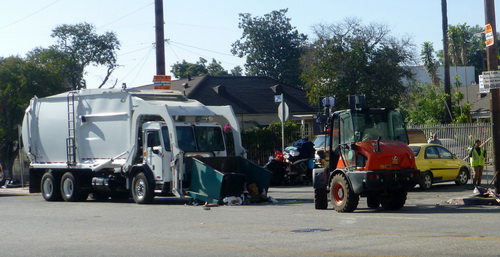
Compactor being fed.
Sanitation had brought one large white compactor truck. A front-end loader made run after run as Sanitation workers filled its hopper and it went over to dump into the compactor truck’s bin. Workers followed up with rakes, as a few feet at a time were cleared. One woman was struggling to dismantle the last tent on the south side of 39th Street, when several rats ran out of it. The Hazmat workers went over and found the tent interior full of rat feces. They confiscated it.
Finally, there was one tent left, on the north side of 39th at Flower. I asked the Newton cop if it was abandoned. No, he said. “She’s always the last.” The tent flap opened and an elderly woman came out. I could see through the flap that the place was immaculately kept, with two small candles in glass cups burning on a little stand.
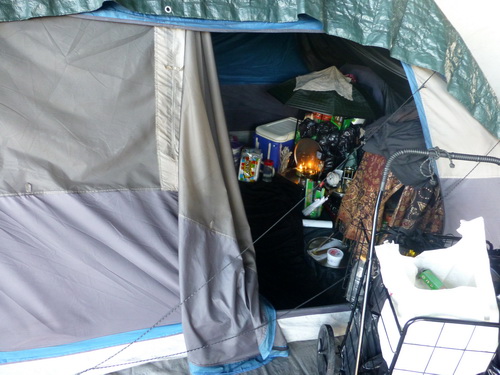
The last tent
It was over. After a little more crushing and raking, the city workers, the police, and the homeless outreach teams would go away – and the residents of the little town could move back in.
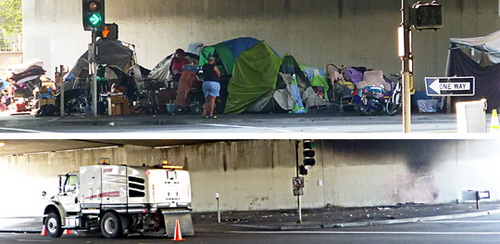
One of the four tent segments before and after.

The next morning. Tent town is back to normal.
Comments
Leave a Reply
You must be logged in to post a comment.



